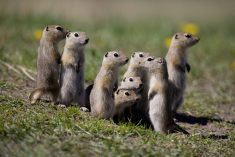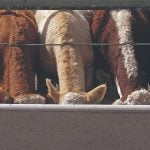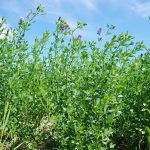It’s the night of the banquet at the Canadian Beef Industry Conference (CBIC) in Penticton, B.C. Cowboy hats are found sporadically throughout the room. Banquet staff have cleared supper plates, and now the crowd’s attention is focused on Duane Thompson with the Canadian Cattle Association (CCA) as he lists all the nominees for the Environmental Stewardship Award (TESA). Outside the ballroom, the setting sun dapples the waters of Okanagan Lake.
In their home province, the Fossens of Bar 7 Ranch are named the winners.
The ballroom erupts in applause and cheers, everyone immediately rising to their feet. The elation is evident, the air electric. The crowd parts and the Fossens emerge, Doug Fossen sporting a grin from ear to ear as he accepts handshakes and climbs the stage with his family to accept the award.
Read Also

The Canadian Cattle Association’s international advocacy efforts
Global ag policies affect Canadian food policy, so the Canadian Cattle Association participates in international and domestic forums
“It was a real shock,” Fossen says in an interview. “Everybody who was nominated is spectacular. Yeah, just top-of-their-class people and they all have an awesome story.
“But that was also really encouraging because I think that shows that there are lots of caring people in our industry and hopefully we can keep moving ahead and doing the right thing for the environment.”
Nominees
TESA nominees are selected by their peers within their region. From there, a panel of judges from Ducks Unlimited, Cows and Fish, and the CCA decide who wins the award by going through what the nominee does on their operation. This includes details from the nominees themselves, letters of support and photos.
“It’s one of the most difficult jobs I do all year long,” says Duane Thompson, the environment committee chair of the CCA.

TESA was created in 1996. The original idea for the award started in the early 1990s, following the start of a provincial stewardship award in Alberta. The goal of the award was to celebrate what was being done in the industry by ranchers and to encourage others to follow suit. It is a very prestigious award that producers all across the country are honoured to be nominated for or win.
“All of the nominees just were outstanding stewards of the environment and this industry, but what really stood out for Bar 7 Seven was they operate in an extremely fragile environment,” Thompson says.
“They’ve worked in that fragile environment, they’ve managed the grass really well, they’re very conscious of the habitat and the species that make their home on their ranch.”
Even though the other nominees didn’t win, Thompson says they still are recognized as successful stewards of the land.
“They’re all just really proud of what they do. And frankly, producers are one of the first environmentalists because our very existence depends on it.”
Bar 7 Ranch
Nestled against the side of a mountain overlooking Rock Creek and the Kettle River is Bar 7 Ranch.
“We do have a little bit of open area for our government land, but a lot of it is forested cut blocks and just rugged B.C. mountains kind of country,” says Doug Fossen, owner and operator of Bar 7 Ranch.
The area is rugged, with cattle grazing on the slope of the mountain, and north of them, a timbered area. Managing a wide expanse of land — 2,300 acres owned, around 2,500 acres rented, and using around 20,000 on their range permit — Fossen and his wife, Erika, as well as their two children often sweep the intricate British Columbia landscape on horseback.

It’s something Doug Fossen has been doing since he was young, ranching with his parents, who bought the ranch in 1976.
“That was the year before I was born,” Fossen explains. “And then my brother was farming with us up until about 10 or 11 years ago, and we have just slowly added land over the years and built the cow herd up. When Erica and I got married in 1999 we had about 150 cows and then we’ve just slowly been adding cows every year.”
But they’re doing more than just managing their commercial cattle herd. They also actively find new ways to improve the environment they ranch on.
Fossen says he grew up in a family where taking care of the environment is important, so he continues those practices.
“We’ve never been the kind of people who just put our head down and work. We’re always thinking, ‘If we’re overworked and overloaded what could we change to make things better?’ And so a lot of the same improvements that help us work less and be more efficient and grow more crops also benefit our ranch and benefit the environment and the wildlife.”
Fire mitigation
British Columbia experiences more forest fires than any other Canadian province. The Government of B.C. says 60 per cent of B.C. forest fires are caused by lightning. From 2011 to 2020, B.C. saw an average of 1,352 forest fires each year. Even as Bar 7 Ranch was named the winner of the TESA award, a forest fire west of Penticton raged, casting a haze over the city.
[RELATED] A rangeland up in flames
As a result, the Fossens have made it a mission for their ranch to help mitigate the risk of forest fires. They do this by working to space out the timber and provide more grazing areas.
“We’re getting into an area where there’s just not much livestock grazing. We have a lot of retired people buying big acres of land. So they’re sitting on these properties and not grazing them, not logging them,” Fossen says.
“I really feel with our management, we can take away some of that risk. Grazing heavily at certain times of the year when there is a fire risk or grazing beside a highway or beside houses, and doing that forest mitigation as well — it just keeps our whole community safe.”
They try to minimize fire risk by logging the area so trees aren’t so close together. They also clean out some underbrush by doing controlled burns. As a result of their work, the community followed suit, as well as the local park.
“When people were involved in that and saw that, then neighbours did little logging jobs on their areas, and the forest company and some of their logging blocks, they followed a similar pattern,” Fossen says.
“And I think that sort of leadership in that direction really helps. They’re so scared of logging and grazing but when they see it done properly, they like the look of it.”
Grazing, irrigation and cropping
Although Fossen says he wouldn’t consider himself a “rotational grazer,” he does use some aspects of rotational grazing, such as the long rest periods. They do this in part to help maintain soil health on their ranch. Fossen says they have started making 10- to 15-acre pens to feed in the winter, which they constantly move around so the manure and urine are spread out across the land.
“We’ve really noticed a difference on our soil using fencing so that it puts the cow manure and feed ground where we need it for crop production.
“We’ve also done that on some grass fields and it’s just amazing to see how much more grass production we’re getting. Instead of having pens where we’re not growing anything, now we’re doubling or tripling our grass production where we’re feeding those animals in the winter.”

When their cattle aren’t grazing in their pastures, Bar 7 Ranch grows crops for their cattle for winter feeding.
Fossen says they pick crops that can handle the B.C. heat and climate.
“That’s how we got into growing corn because we actually figured out that it’s quite an economical user of water,” he says. “And so we’ve switched to a little bit of corn and then doing our rotation with grass and alfalfa and some for forage, or grain crops as well like some peas and oats and barley and triticale mixed together.”
When they irrigate, Fossen says they only use surface water.
“We’ve really worked on making ourselves more efficient, putting in centre pivots, and improving our irrigation over the last few years.”
TESA winners
Fossen recognizes what Thompson has said about his home — the fragility of the environment around them in southern B.C. Despite this, they continue striving for success and to be stewards of the environment.
“It’s tough ranching in southern B.C.,” Fossen says, “so it is nice to be recognized for that. There is nothing easy about it. Some days you wouldn’t wish it on somebody. But it’s nice to be recognized that we are working in the direction that our industry has to go and hopefully we can be an encouragement to people who are working away with the same idea of just raising quality livestock and raising good kids and families and hopefully being a benefit to the community around us.”
Bar 7 Ranch will continue to expand this type of work. Fossen says they applied for another kilometre of fence for him to build, which they’ll use for more rotational grazing. They also hauled in chicken manure for the fields that needed more nutrients.
“We’re trying to make our farm more efficient,” he says.
Cattle producers and the environment
Bar 7 Ranch and the other TESA nominees aren’t the only cattle producers in the country who are using their ranching practices to better the environment. Thompson says producers all across Canada are active stewards of the environment.
However, Thompson says TESA is important because consumers need to be aware of the good the industry is doing.
“My grandparents, my great-grandparents, and even my father would never have dreamt of having to promote or even justify producing food,” he says. “But the very fact that we are less than one per cent of the population now, the other 99 per cent, there’s not a whole lot that know a lot about our production systems and how we produce the food for them. And to my grandfather … a lot of people had a real strong connection to where their food came from. But now a lot of people don’t. And now we have to tell our story.”
Canadian cattle producers manage about 68 per cent of wildlife habitat on their pasture lands. Although the greenhouse gas footprint of Canadian beef production is 11.04 kg CO2, this represents only 2.4 per cent of the overall emissions in Canada and is offset by the 1.5 billion tonnes of carbon that grasslands use for carbon sequestration.
“I guess that’s been one of our downfalls … is we’re not really good at going on and saying, ‘Look at me, look at what I’m doing’. We do it because it’s our life. And it’s what we love to do,” Thompson says. “And the fact is, there’s a lot of improvement to be made in some areas and on some things, but by and large, ranchers and farmers are really proud of being sustainable and building a system to produce sustainable food in a sustainable environment.”

















